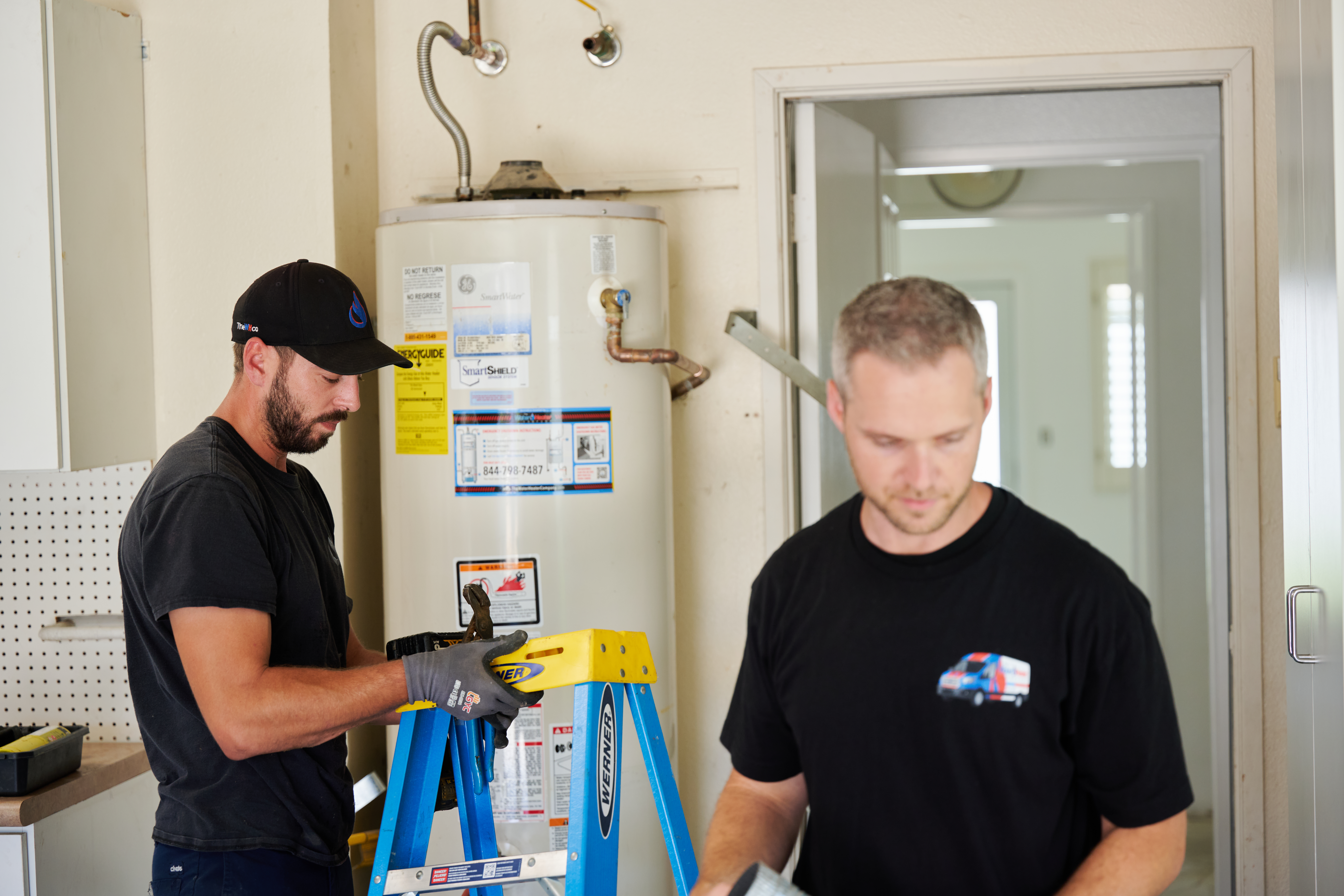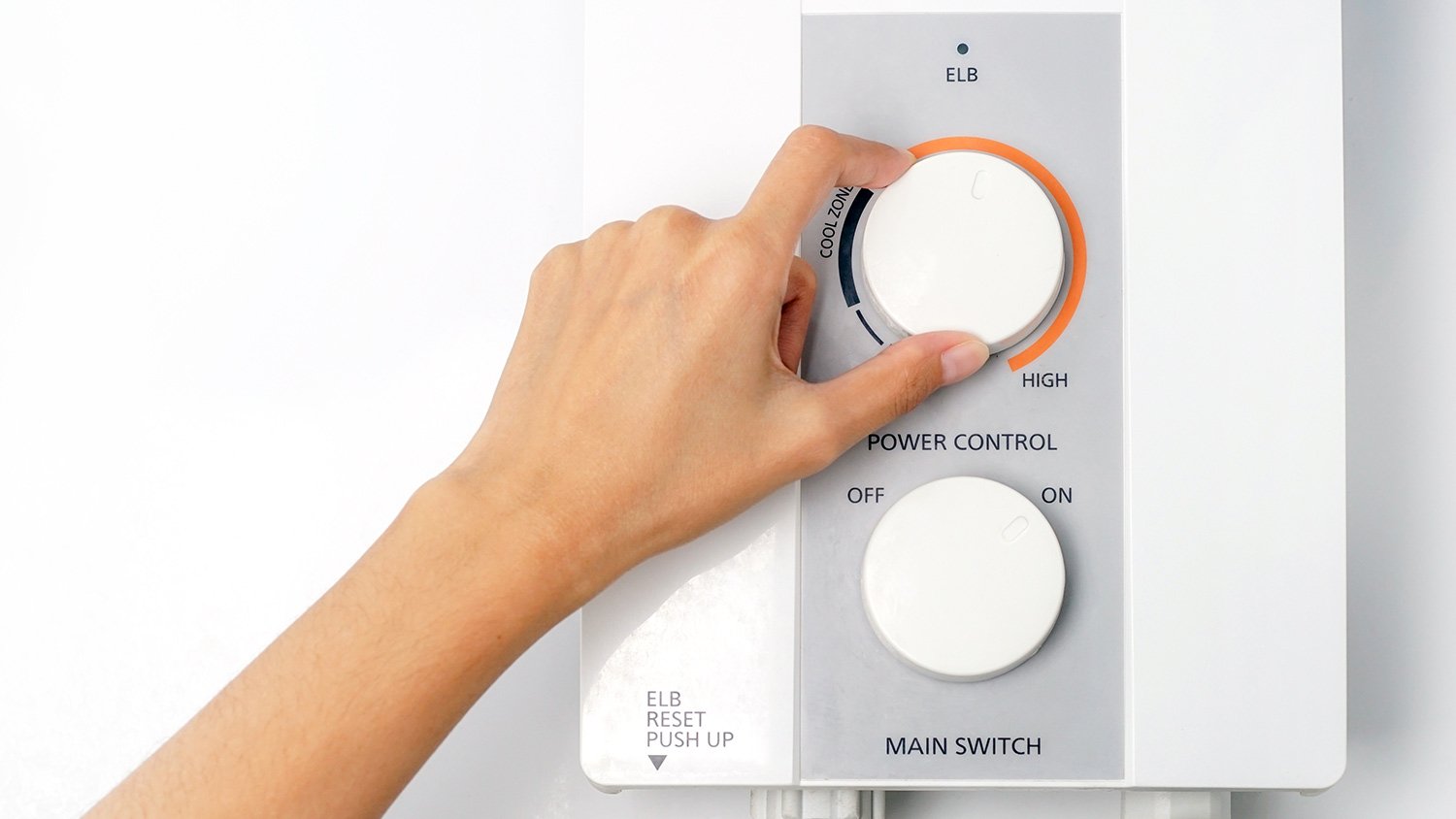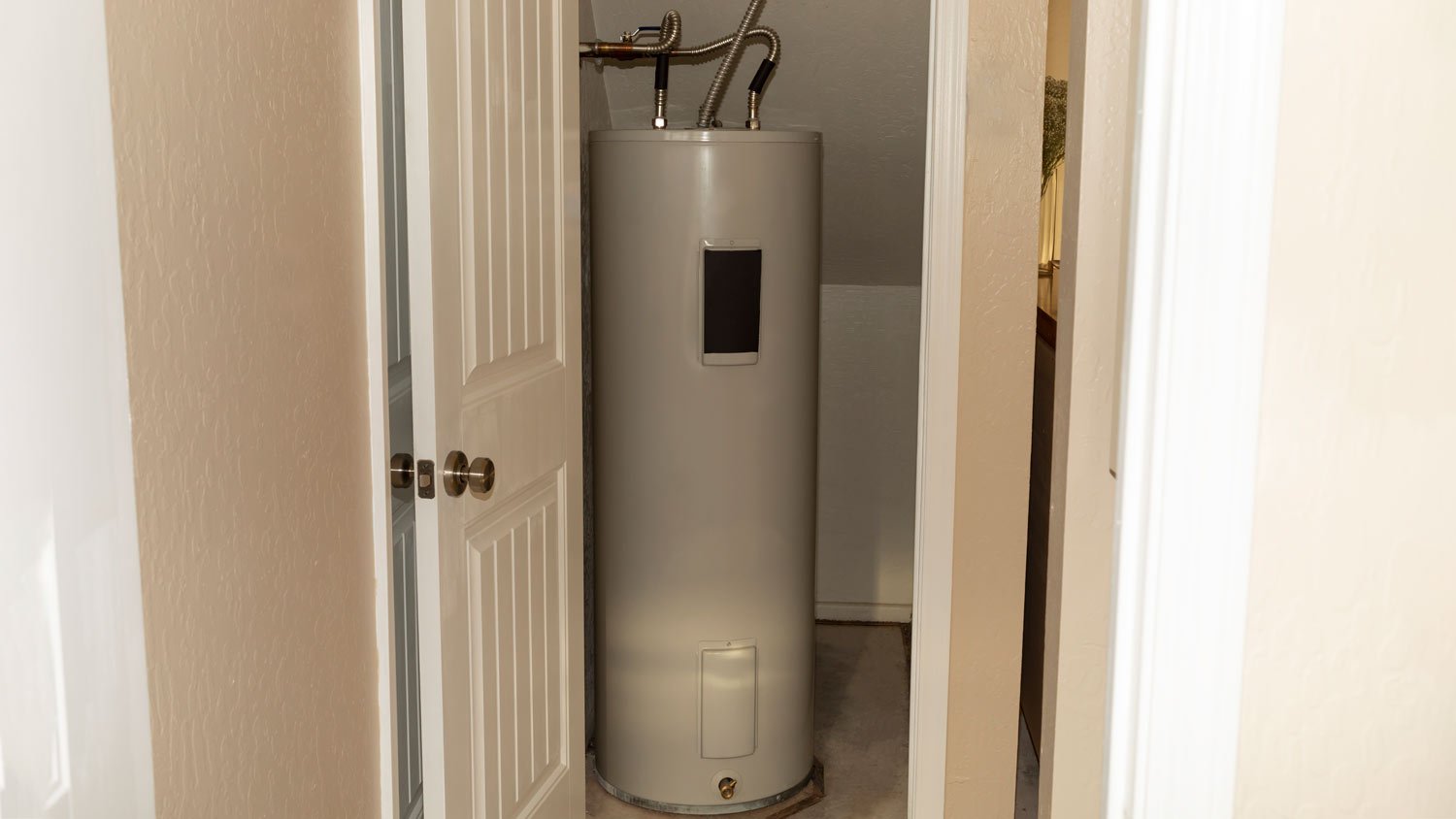
Learn about the different factors that go into water heater gas valve replacement costs to see if you should DIY the project or call a pro.
Lukewarm water heaters are no fun, especially when all you want is a long, hot shower


Rule out the easy fixes before moving on to the more complicated and costly ones.
A faulty or too-low thermostat is a common cause of lukewarm hot water.
Repairing a water heater costs around $590, while a new unit costs around $1,300.
Contact a plumber if you can’t fix your water heater.
There are several reasons why your hot water heater is not getting hot enough. It might be a simple fix, like a tripped breaker, or it could indicate a bigger problem with your water heating system. In some cases, it could be a sign that your water heater is failing, which costs between $225 and $960 on average to repair. But before ruling that you need to change out your water heater, consider these 14 reasons why your water is only getting warm—and what to do about it.

Many homeowners turn down the thermostat on their hot water heaters during the summer to save money and conserve energy. The trick is to remember to turn it back up in the winter. Luckily, this one’s an easy fix.
Check the thermostat on your water heater and your manufacturer’s recommended range to make sure it’s set to the correct temperature. The ideal temperature to save on energy is 120 degrees Fahrenheit, but you can crank the heat up to as high as 140 degrees.
Note that some people who are immunocompromised need higher temperatures for health reasons. Meanwhile, people who live in a multi-family home may need the increased temperature for the water heater to keep up with the demand for hot water.
If your water heater gradually went from lukewarm to room temperature to cold, then it’s probably a good idea to check the breaker or fuse box. If you have a tripped breaker or blown fuse, the water in the tank could still stay warm for several days before losing all heat. This can make it seem like there’s a technical problem with the equipment when, really, you just don’t have power.
Flip the switch back to “ON” or replace the blown fuse. If you notice other electrical problems or the circuit continues to trip, then you may need to call in an electrician near you to get to the root of the issue. Don’t attempt to repair electrical wiring yourself—especially if water-using appliances are involved—as this can put you at risk of electrocution.
If you turn up the thermostat on your hot water tank and don’t feel an increase in water temperature, your thermostat may be broken.
You can test your water heater thermostat with a multimeter to see if it requires replacement. If it does, there’s not a great DIY solution. Call a hot water heater repair professional near you to replace your thermostat.
Water that enters your water heater carries particles like dirt and sediment with it, and eventually, those can build up in the tank. Because the buildup happens at the bottom where the heater is, sediment buildup can lead to lukewarm water production. Hard water carries more minerals than soft, so if you live in an area with hard water, this could be the culprit.
To get the hot water flowing again, drain the tank and consider installing a water softener.
Though it may not be visible, your water tank may have sprung a leak.
If you suspect a leak, call a professional. Even if you’re a DIY die-hard, leaks are best handled by a professional to avoid causing further issues. Incorrectly replacing a leaky valve under your water heater can lead to more leakage, which could puddle on your floor and cause mold and mildew or structural damage to your home.
You may be creating too much demand without enough hot water supply. This can happen if you’ve moved into a new home, added bathrooms, or expanded your family, in which case your home’s demand is more than your heater can handle. There might also be too much demand if you’ve got the washing machine, dishwasher, or other appliances all running at once.
Try spacing out your chores—ideally, run the dishwasher and washing machine when no one in the house is showering.
Alternatively, consider a tankless water heater, which could be 25% to 35% more energy efficient than a traditional water heater. Tankless water heaters can also save space, as they don’t store hot water but heat it on demand for each use.
While tankless heaters are a great choice when replacing your water heater, it is imperative that they are maintained at least annually to guarantee that they continue to perform at peak efficiency for years to come.
The flow rate refers to the gallons per minute (GPM) your hot water tank is producing to keep up with the demand in the house. If the flow rate for each faucet is high, not enough hot water will get to each tap. This could be one reason you have no hot water with a tankless water heater.
Install low-flow faucets and showerheads to conserve water and increase the amount of hot water that gets to your tap.
Electric water heaters have two heating elements, and if one of them breaks, the other has to make up the difference. This lack of efficiency can result in lukewarm water from your faucets.
Regular maintenance can stave off a failure, but in the event one goes bad, call in a pro to replace the faulty water heater element.
The valve in gas water heaters usually lasts around 10 years, after which it becomes susceptible to damage. If you notice a funny smell like garbage or rotten eggs, that’s an indicator that your gas valve has broken and there’s a leak.
Call in a professional and possibly your gas company. Gas valves cannot be repaired, so if there’s a problem with your gas valve, it will need to be replaced. Gas is extremely dangerous to work with if you don’t have the proper professional training, and performing a repair incorrectly can lead to a leak, which is not only a health hazard if you’re inhaling it, it can also lead to an explosion. Seriously, don’t try to DIY this one.
The dip tube, also called the anode rod, pushes cold water down into the bottom of your tank to be heated. When the dip tube malfunctions, the water doesn’t get pushed down into the heating mechanism. As a result, your heater becomes less efficient and more likely to put out lukewarm water. Dip tubes last an average of eight to 12 years, so it’s possible that the dip tube needs replacing a few years before your water heater.
Contact a local plumber if you suspect a broken dip tube to get it replaced.
Cross connections, where potable water comes into contact with non-potable, usually occur in older plumbing systems. Since these problems may originate outside your home, they are difficult to identify until you’ve ruled out other problems. If you have eliminated other possible causes of your water heater only producing lukewarm water, a cross-connection may have occurred when the city was updating plumbing near your home.
Botelho says another type of cross-connection that can cause your hot water to cool down is when a mixing valve or a recirculating system fails. Mixing valves allow hot and cold water to mix together and if the mixing valve fails, this can cause water to pass through it when it is turned off. This, in turn, allows hot water to migrate into the cold water side, reducing the amount of available hot water when another fixture or faucet is turned on.
Contact your plumber and your city if you suspect there’s a cross-connection.
If you notice your water is not getting hot enough in the wintertime, then it might be a matter of poor insulation. Homes in extremely cold climates may need insulation to prevent heat from slipping away from the water heater. Even homes in warmer climates can feel the impact of a cold spell on a hot water heater as it struggles to perform at its usual capacity.
The best solution for this issue is to insulate your water heater. Pipe insulation may also help prevent the water from cooling as it flows to your faucets.
Your water heater might not be the culprit. A clogged pipe can cause low hot water pressure, which may make it seem like the water heater isn’t working. One telltale sign that you have a clogged pipe on hand is lower water pressure or hot water temperature issues from only a single source.
If the temperature is low enough for pipes to freeze, usually in the 20-degree zone or colder for prolonged periods, then your clogged pipe could be a frozen pipe. Be sure to winterize your home ahead of time and unfreeze the pipes before they burst.
If a clogged pipe is affecting the hot water flow, you cannot fix it by pouring liquid cleaner into the drain. However, you can try flushing the system by turning off the water supply to the water heater, attaching a hose to the drain valve at the bottom of the heater, and letting the water run for a few minutes to get rid of sediment or debris.
If the issue persists or you’re unsure how to clean out the clog, it’s best to contact a local plumber.
Sometimes, it’s simply the end of the line for your water heater. Like any appliance, water heaters have a limit to how long they last and how efficient they are toward the end of their life spans. The average water heater life span is 10 years but can range from six to 15 years depending on the brand, how well you maintained it, the water hardness level, and the demand.
If your unit is approaching the 10-year mark, it’s likely time to replace it with a newer, more efficient model. If you have concerns about your water heater or want to replace it, it's best to hire a pro to do the job. The typical cost to replace a water heater is $900 to $1,800, or $1,300 on average.
While some hot water heater issues can be fixed with basic troubleshooting, certain problems require hiring a local water heater pro. If you've already checked the thermostat settings, flushed the tank to remove any sediment buildup, and checked if the breaker is tripped, but your water is still not hot enough, it's time to call a pro. Persistent lukewarm water could indicate a failing heating element, a malfunctioning gas valve, or a deeper issue within the system that requires a pro to diagnose and fix.
Calling a professional ensures that complex issues are accurately diagnosed and safely repaired. Attempting DIY fixes can lead to further damage, safety hazards, or voiding the water heater’s warranty. Also, if your water heater is over a decade old and struggling to maintain heat, a pro can assess whether a repair or full replacement is the best option.
Dave came by to check out a problem with our hot water becoming lukewarm after just a few minutes of running the shower. He inspected our gas hot water heater but determined that, although it would likely need replacing in another year or so, it was still functional. He checked our shower...
My water heater started leaking and clearly was at the end of its life. Mike was out here within an hour and took care of things. I also took the opportunity to upgrade to a larger capacity water heater. Professional, friendly, clean, and efficient! Highly recommend.
Went well. Very professional, removed old Hot water heater, installed new hot water heater and cleaned up very quickly.
Purchased a 75 gallon water heater with install coupon from angie's list. Their service is punctual, honest and the gentleman who stopped by knew exactly what he was doing. Great prompt service. Would definitely recommend to anyone installing a water heater.
Brandon came out and replaced the gas hot water heater and replaced some older shut off valves as well. He showed me a leak on the original hot water heater, so getting it replaced was timely. The whole job took close to 5 hours due to the very tight space to work in but he made it ...
My experience with Dito was excellent. He is very professional and arrived right on time. He located the water line and replaced my water heater. He is a very hard worker. I highly recommend him. It is nice to find someone who enjoys there work. Thank You Dito
From average costs to expert advice, get all the answers you need to get your job done.

Learn about the different factors that go into water heater gas valve replacement costs to see if you should DIY the project or call a pro.

Find out the average tankless water heater repair cost, what impacts pricing, and how to save. Get expert tips to plan your repair budget with confidence.

Running out of hot water too quickly or hearing strange noises when you call for hot water? Use this water heater repair cost guide to see what a fix will cost.

Learning how to replace a water heater in your home is a challenging task that most people will want to leave to the professionals. But if you’ve got expert-level skills, here’s what to do.

Use this guide on how to turn off your water heater’s gas supply if you run into an emergency or want to conserve gas while you’re on vacation.

If your water heater isn't heating up properly, you could have a drainage issue. These common causes of water heater not draining could be to blame.